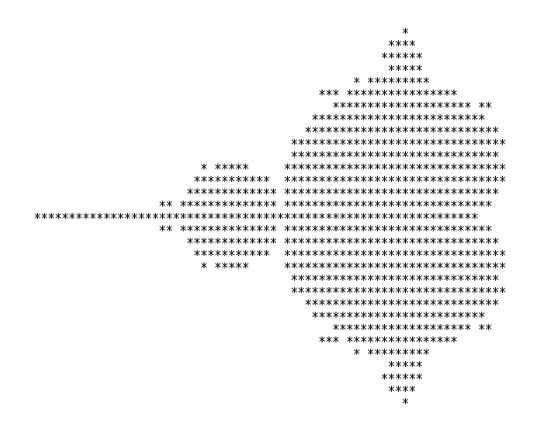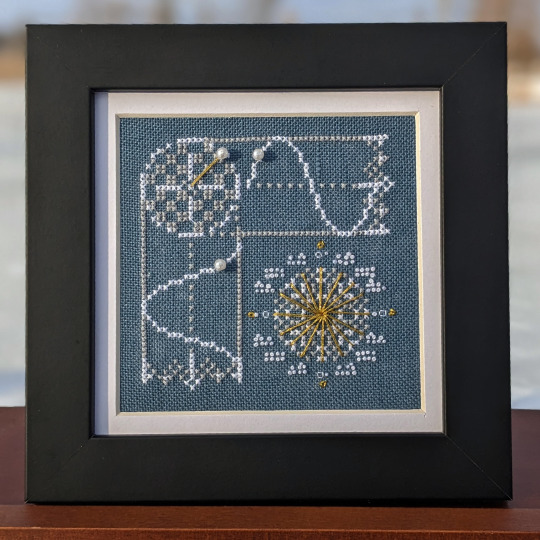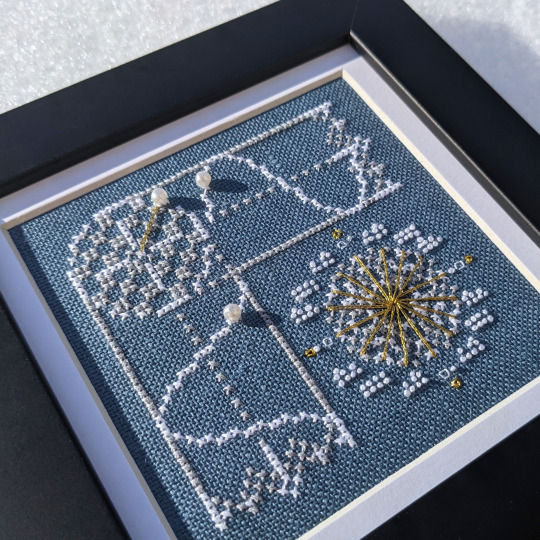Mathematical stitching 🪡A PhD student hoping to inspire crafty folks to engage with maths - all designs have a free pattern on my website!
Don't wanna be here? Send us removal request.
Text



This embroidery recreates the first published image of the Mandelbrot set from 1978, using thread to capture its striking symmetry and spiky outline. The Mandelbrot set is a famous fractal formed by repeatedly applying an iterative equation to the complex numbers. Each complex number can be represented as a point on a 2D plane. If the results of the iterative equation starting at a specific point stay bounded, the point is in the Mandelbrot set. Points outside the set are generally coloured based on how fast they escape, forming the fiery fringes around the edge.
#embroidery#math art#mathblr#math embroidery#fiber craft#craft#math#science craft#yarnblr#threadedtheorems#mandelbrot set#fractal#fractal art
46 notes
·
View notes
Text

Each curve in this embroidery traces the path of slow moving fluid around a sphere—stitched by hand, shaped by maths.
[Free embroidery pattern]
#embroidery#fiber craft#math art#math embroidery#craft#math#mathblr#science craft#yarnblr#threadedtheorems
13 notes
·
View notes
Text

This embroidery captures a fragment of the Penrose tiling, a mathematical marvel where two simple shapes—a kite and a dart—come together to form a pattern that never repeats.
Unlike checkerboards or honeycombs, this tiling is aperiodic: every little motif (like this star) pops up infinitely often, but there’s no way to slide the whole thing and make it match itself.
This section is from the P2 tiling, one of several discovered by Roger Penrose in the 1970s.
[Free embroidery pattern]
#embroidery#fiber craft#mathblr#math embroidery#math art#math#craft#science craft#yarnblr#threadedtheorems
16 notes
·
View notes
Text

This embroidery traces the streamlines of slow, sticky flow—what mathematicians call Stokes flow. ✨
In this regime, everything moves smoothly and predictably, like a billiard ball sinking into syrup. The closer the lines, the faster the flow. Far away, the sphere’s influence fades, and the lines stretch out to be uniform. [Free embroidery template]
#embroidery#math art#fiber craft#math embroidery#craft#mathblr#science craft#yarnblr#math#threadedtheorems
16 notes
·
View notes
Text
Gender equality? Broke. Gender bijective homomorphism? Woke
193 notes
·
View notes
Text
Fiber arts is just Math in sheep's clothing
25K notes
·
View notes
Text

Meet the spectre 👻 the first-ever true aperiodic monotile. For ages, no one knew if a single shape could tile the plane without ever repeating. This tiling uses just one tile, no reflections, has no patterns, and fills space perfectly
[Free embroidery pattern]
70 notes
·
View notes
Text
not to sound corny but the textile arts make me feel connected to the world around me. it's so intentional and deliberate and when i sit and do it, i think a lot about how many other women that came before me used to do it, how many hands have used the same supplies i am using, and how many other people might be doing the same thing as me all across the world right now
16K notes
·
View notes
Text

Zoom in on some tiling magic ✨ This Penrose star is part of an an aperiodic tiling made from just kites and darts—no repeating pattern, no matter how far you zoom out. Every piece pops up again somewhere, just never in the same arrangement. It’s like symmetry got bored and decided to be interesting instead
[Free embroidery pattern]
12 notes
·
View notes
Text
One thing I love about studying math is that when you ask any fellow student or prof why they went into math we all say it’s because we find it beautiful. It’s so diametrically opposed to the opinion that everyone else has about math that it feels like some kind of virus that infects you and makes you unable to study anything else
1K notes
·
View notes
Text

Close-up of the chaos! These swirling stitches follow the Lorenz system’s rules. Even the tiniest change in starting point decides how many times we loop each lobe. One stitch to the left? Whole new journey
[Free embroidery pattern]
#embroidery#mathblr#math art#fiber craft#math embroidery#science craft#yarnblr#craft#math#threadedtheorems
34 notes
·
View notes
Text
One should always have at least 2 craft projects going. That way, when one of them is messed up and misbehaving, you can switch to another, and let the first one sit there and think about what it's done.
78K notes
·
View notes
Text

A Penrose star in all its glory 🌟 Built from just kites and darts, it looks symmetrical, but it’s secretly rebellious - the big picture of the Penrose tiling refuses to fall into a pattern.
[Free embroidery pattern]
27 notes
·
View notes
Text
Why do mathematicians love pi so much? It's related to some shape, but they like that shape because it explains why pi shows up? Sounds like circular reasoning to me
840 notes
·
View notes
Text

The Lorenz system describes how a point’s position in 3D space changes over time, showing chaotic behaviour. The resulting path forms butterfly-shaped lobes. Small changes in the starting point lead to vastly different trajectories around the lobes. This concept is linked to the "butterfly effect" in chaos theory. Free embroidery pattern
#embroidery#fiber craft#mathblr#yarnblr#math art#craft#science craft#math embroidery#math#threadedtheorems
73 notes
·
View notes
Text


HAPPY PI DAY!
For this year's celebratory pattern I wanted to tackle a dream project of mine: stitching a functional unit circle. The French knots (all 100 of them!) around the lower circle represent the coordinates of each point (sans radicals and negative signs), and the upper circle shows how sine and cosine can be found by following a point around a circle's circumference.
[pattern here] [previous pi day patterns here]
3K notes
·
View notes
